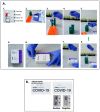Analytical Evaluation of Visby Medical RT-PCR Portable Device for Rapid Detection of SARS-CoV-2
- PMID: 33947153
- PMCID: PMC8146445
- DOI: 10.3390/diagnostics11050813
Analytical Evaluation of Visby Medical RT-PCR Portable Device for Rapid Detection of SARS-CoV-2
Abstract
Extended community testing constitutes one of the main strategic pillars in controlling the COVID-19 pandemic. Reverse transcription PCR (RT-PCR) targeting the SARS-CoV-2 genome on nasopharyngeal swab samples is currently the reference test. While displaying excellent analytical sensitivity and specificity, this test is costly, often requires a substantial turnaround time, and, more importantly, is subject to reagent and other material shortages. To complement this technology, rapid antigen tests have been developed and made available worldwide, allowing cheap, quick, and decentralized SARS-CoV-2 testing. The main drawback of these tests is the reduced sensitivity when RT-PCR is the gold standard. In this study, we evaluate Visby an innovative, portable, easy-to-use RT-PCR point-of-care (POC) diagnostic device. Our retrospective analysis shows that overall, compared to the Cobas 6800 RT-qPCR assay (Roche), this RT-PCR POC technology detects SARS-CoV-2 RNA with 95% sensitivity (95%CI = 86.3-99%) and 100% specificity (95% CI = 80.5-100%). For samples with cycle-threshold values below 31, we observed 100% sensitivity (95% CI = 66.4-100%). While showing an analytical sensitivity slightly below that of a standard RT-qPCR system, the evaluated Visby RT-PCR POC device may prove to be an interesting diagnostic alternative in the COVID-19 pandemic, potentially combining the practical advantages of rapid antigen tests and the robust analytical performances of nucleic acid detection systems.
Keywords: POCT techniques; SARS-CoV-2; rapid diagnostic techniques.
Conflict of interest statement
The authors declare that there are no conflicts of interest.
Figures


References
-
- Udugama B., Kadhiresan P., Kozlowski H.N., Malekjahani A., Osborne M., Li V.Y.C., Chen H., Mubareka S., Gubbay J.B., Chan W.C.W. Diagnosing COVID-19: The Disease and Tools for Detection. [(accessed on 10 December 2020)];ACS Nano. 2020 14:3822–3835. doi: 10.1021/acsnano.0c02624. Available online: https://www.ncbi.nlm.nih.gov/pmc/articles/PMC7144809/ - DOI - PubMed
-
- Dinnes J., Deeks J.J., Adriano A., Berhane S., Davenport C., Dittrich S., Emperador D., Takwoingi Y., Cunningham J., Beese S., et al. Rapid, point-of-care antigen and molecular-based tests for diagnosis of SARS-CoV-2 infection. [(accessed on 10 December 2020)];Cochrane Database Syst. Rev. 2020 8:CD013705. Available online: https://www.cochranelibrary.com/cdsr/doi/10.1002/14651858.CD013705/full. - DOI - PMC - PubMed
-
- Joung J., Ladha A., Saito M., Segel M., Bruneau R., Huang M.W., Kim N.-G., Yu X., Li J., Walker B.D., et al. Point-of-care testing for COVID-19 using SHERLOCK diagnostics. [(accessed on 10 December 2020)];medRxiv. 2020 doi: 10.1101/2020.05.04.20091231. Available online: https://www.ncbi.nlm.nih.gov/pmc/articles/PMC7273289/ - DOI
-
- Gibani M.M., Toumazou C., Sohbati M., Sahoo R., Karvela M., Hon T.-K., De Mateo S., Burdett A., Leung K.Y.F., Barnett J., et al. Assessing a novel, lab-free, point-of-care test for SARS-CoV-2 (CovidNudge): A diagnostic accuracy study. Lancet Microbe. 2020;1:e300–e307. doi: 10.1016/S2666-5247(20)30121-X. - DOI - PMC - PubMed
LinkOut - more resources
Full Text Sources
Other Literature Sources
Miscellaneous

